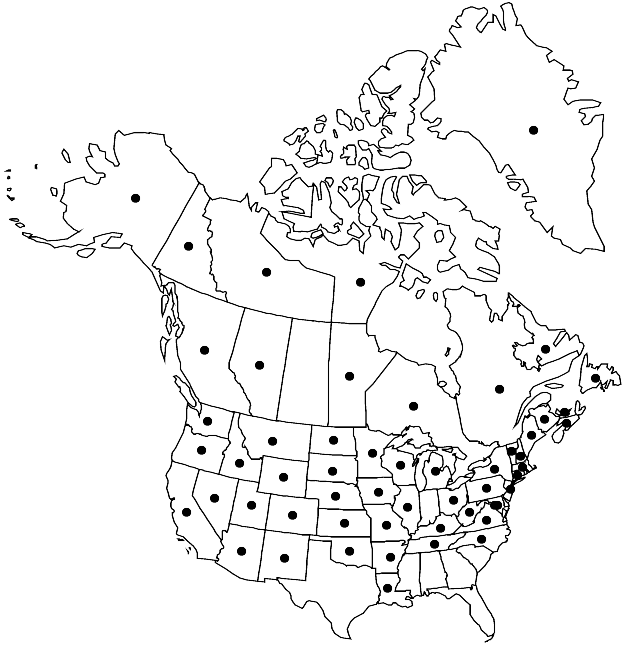Difference between revisions of "Pohlia wahlenbergii"
in A. J. Grout, Moss Fl. N. Amer. 2. 203. 1935.
FNA>Volume Importer |
FNA>Volume Importer |
||
| Line 33: | Line 33: | ||
|elevation=low to high elevations | |elevation=low to high elevations | ||
|distribution=Greenland;Alta.;B.C.;Man.;N.B.;Nfld. and Labr.;N.W.T.;N.S.;Nunavut;Ont.;P.E.I.;Que.;Yukon;Alaska;Ariz.;Ark.;Calif.;Colo.;Conn.;D.C.;Idaho;Ill.;Iowa;Kans.;Ky.;La.;Maine;Md.;Mass.;Mich.;Minn.;Mo.;Mont.;Nebr.;Nev.;N.H.;N.J.;N.Mex.;N.Y.;N.C.;N.Dak.;Ohio;Okla.;Oreg.;Pa.;S.Dak.;Tenn.;Utah;Vt.;Va.;Wash.;W.Va.;Wis.;Wyo.;Mexico;Central America;South America;Eurasia;Antarctica. | |distribution=Greenland;Alta.;B.C.;Man.;N.B.;Nfld. and Labr.;N.W.T.;N.S.;Nunavut;Ont.;P.E.I.;Que.;Yukon;Alaska;Ariz.;Ark.;Calif.;Colo.;Conn.;D.C.;Idaho;Ill.;Iowa;Kans.;Ky.;La.;Maine;Md.;Mass.;Mich.;Minn.;Mo.;Mont.;Nebr.;Nev.;N.H.;N.J.;N.Mex.;N.Y.;N.C.;N.Dak.;Ohio;Okla.;Oreg.;Pa.;S.Dak.;Tenn.;Utah;Vt.;Va.;Wash.;W.Va.;Wis.;Wyo.;Mexico;Central America;South America;Eurasia;Antarctica. | ||
| − | |discussion=<p>Pohlia wahlenbergii is one of the most geographically widespread and common species of the genus. The leaves are pale whitish, decurrent, and have lax, thin-walled cells. The species varies greatly in size from very slender delicate plants in suboptimal habitats to large and deep cushions in cold high altitude and latitude sites. Large plants of P. wahlenbergii typically have red stems and sometimes reddish pigmentation to the leaves as well. Some authors refer large expressions to var. glaciale (or P. glaciale), but gradation in size and pigmentation is completely continuous, and different collectors draw the line between the typical variety and var. glaciale at different points. The exothecial cell walls in capsules of this species are somewhat collenchymatous.</p> | + | |discussion=<p><i>Pohlia wahlenbergii</i> is one of the most geographically widespread and common species of the genus. The leaves are pale whitish, decurrent, and have lax, thin-walled cells. The species varies greatly in size from very slender delicate plants in suboptimal habitats to large and deep cushions in cold high altitude and latitude sites. Large plants of <i>P. wahlenbergii</i> typically have red stems and sometimes reddish pigmentation to the leaves as well. Some authors refer large expressions to var. glaciale (or P. glaciale), but gradation in size and pigmentation is completely continuous, and different collectors draw the line between the typical variety and var. glaciale at different points. The exothecial cell walls in capsules of this species are somewhat collenchymatous.</p> |
|tables= | |tables= | ||
|references= | |references= | ||
| Line 57: | Line 57: | ||
|publication year=1935 | |publication year=1935 | ||
|special status=Selected by author to be illustrated | |special status=Selected by author to be illustrated | ||
| − | |source xml=https://jpend@bitbucket.org/aafc-mbb/fna-data-curation.git/src/ | + | |source xml=https://jpend@bitbucket.org/aafc-mbb/fna-data-curation.git/src/8f726806613d60c220dc4493de13607dd3150896/coarse_grained_fna_xml/V28/V28_341.xml |
|genus=Pohlia | |genus=Pohlia | ||
|species=Pohlia wahlenbergii | |species=Pohlia wahlenbergii | ||
Revision as of 17:04, 18 September 2019
Plants small to very large, whitish or sometimes in large forms reddish, dull. Stems 0.8–10 cm. Leaves laxly spreading to more stiffly erect, lanceolate to ovate-lanceolate, 0.6–1.2 mm; margins weakly to strongly serrulate in distal 1/3; costa ending well before apex; distal medial laminal cells laxly and broadly hexagonal to rhomboidal, 65–110 µm, walls thin. Specialized asexual reproduction absent. Sexual condition dioicous; perigonial leaves ovate; perichaetial leaves weakly differentiated, lanceolate. Seta orange-brown. Capsule inclined ± 180°, brown to red-brown, sometimes stramineous, short-pyriform to urceolate, neck less than 1/3 urn length; exothecial cells isodiametric, walls sinuate; stomata immersed; annulus absent; operculum short- to long-conic; exostome teeth light brown to red-brown, triangular-acute; endostome hyaline to yellow, basal membrane 1/2 exostome length or slightly longer, segments tapered apically, distinctly keeled, broadly perforate, cilia long, nodulose. Spores 15–21 µm, finely roughened.
Phenology: Capsules mature spring (Apr–Jun).
Habitat: Disturbed clay or rarely sandy soil, path banks, along streams
Elevation: low to high elevations
Distribution

Greenland, Alta., B.C., Man., N.B., Nfld. and Labr., N.W.T., N.S., Nunavut, Ont., P.E.I., Que., Yukon, Alaska, Ariz., Ark., Calif., Colo., Conn., D.C., Idaho, Ill., Iowa, Kans., Ky., La., Maine, Md., Mass., Mich., Minn., Mo., Mont., Nebr., Nev., N.H., N.J., N.Mex., N.Y., N.C., N.Dak., Ohio, Okla., Oreg., Pa., S.Dak., Tenn., Utah, Vt., Va., Wash., W.Va., Wis., Wyo., Mexico, Central America, South America, Eurasia, Antarctica.
Discussion
Pohlia wahlenbergii is one of the most geographically widespread and common species of the genus. The leaves are pale whitish, decurrent, and have lax, thin-walled cells. The species varies greatly in size from very slender delicate plants in suboptimal habitats to large and deep cushions in cold high altitude and latitude sites. Large plants of P. wahlenbergii typically have red stems and sometimes reddish pigmentation to the leaves as well. Some authors refer large expressions to var. glaciale (or P. glaciale), but gradation in size and pigmentation is completely continuous, and different collectors draw the line between the typical variety and var. glaciale at different points. The exothecial cell walls in capsules of this species are somewhat collenchymatous.
Selected References
None.
